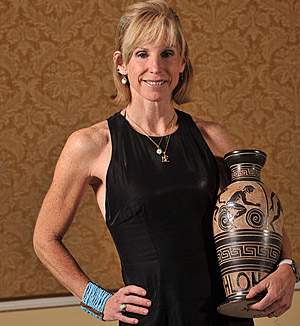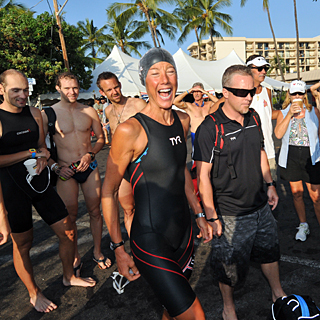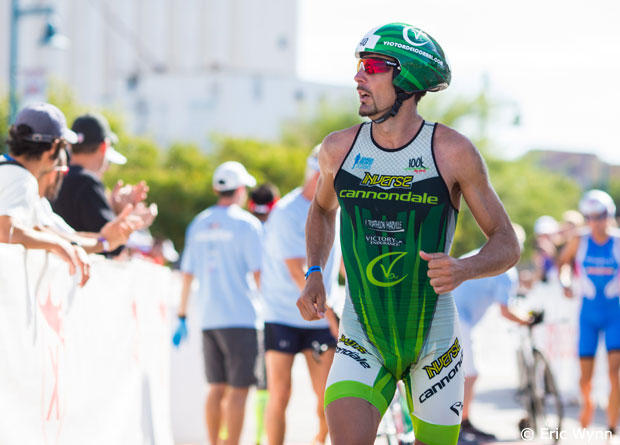Summer of ’92

Yes, it’s amazing what has been accomplished by one of triathlon’s newest stars, Victor Del Corral. The Spaniard finished a 2-week double: 7:55 at Ironman Florida, with a 2:37 marathon to haul in early bike leader Andrew Starykowicz, and then reeled in early leader Jordan Rapp in Arizona, winning in 8:02 with a 2:43 marathon.
I heard a rumor that Del Corral’s entered in Ironman Cozumel, 2 weeks from now. I asked Victor via email if that’s true, I have no reply yet. That, of course, would be stratospheric, were he to win that race as well. Certainly nothing like that has ever been accomplished.
Oh, you puppies. Bless your hearts, those who’re new to the sport and by “new” I mean any of you who’ve only been around triathlon for the last 20 years or so. Let me take you back.
The hardest race, the largest prize purse, the most coveted win outside of Kona in the world of multisport during the decade of the 90s was Powerman Zofingen, the hard-as-hell run-bike-run. Everyone came. Everyone peaked for this race. This is the place the best in both duathlon and triathlon met.
Paula Newby-Fraser, the 8-time Kona champ, won this race in 1991, with one of only two sub-7hr finishes by a woman ever recorded on this course. She did not win the race in 1992, rather it was won by her arch rival during her era, the great Kiwi Erin Baker, who recorded the other sub-7 performance. Both these extraordinary women raced this course in 6:58.
So, yes, Paula raced Zofingen in May of 1992. She was just warming up.

A month later was the first of a string of races that place Del Corral’s victories in historic perspective. That was the Nice Triathlon, the site of the current Ironman Nice, but of a shorter distance. That race, then, consisted of a 4k swim, 120k bike and 30k run. Still, it was considered almost suicidal to race Zofingen followed 4 weeks later by Nice, and most who who tried it failed. It was just not possible to recover from Zofingen in time. Like those trying to win the Giro and the Tour in the same year, yes, it's possible, but not advisable. However, Paula did it, and won it.
But she was just getting into the groove. Two weeks later was Ironman Japan. This was not spur of the moment.
“I had a contract to go to Nice to race, and also a deal to race in Japan. These and Zofingen were always part of the plan. There were good contracts with events – appearance fess, travel, etc. These deals were done way early in the year.“
She felt she could handle all 3 of these races. She was obviously right, as she won both Nice and Ironman Japan. Was this just for money?
“That would be very un-Paula-like,” said her agent through most of her racing career, Murphy Reinschreiber. “She would never do anything for money. That never figures into her decision-making. [Her racing schedule] was based on science as she knew it. It was just something she decided she could do.”
Murph, did you try to talk her out of it? I mean, this seems a little over-the-top in retrospect.
“There was no way to protect her. She got the bit between her teeth, this was doable, she could do it, no reasoning with her. In a way it was out of control. But there was no arguing with Paula. She was very specific about what she did, very scientific, but she pulled it off."

Paula herself felt that this was not an unreasonable race schedule, as she planned it out, mathed it out. She would, as she put it, “train in winter and then line up a stretch of racing lasting until mid July.” That was the way the schedule worked for most long coursers at that time. Then she would, “start Kona prep later in August.”
She, and all the long coursers, trained from February on for a peak in May or June. Then, in between these races she did, “very little training in between. Just maintenance.”
Big deal, you might be thinking. 2 races, 2 weeks apart. And one not an Ironman. How hard is that? But Paula wasn’t done yet.
“Ironman Germany [what is now Challenge Roth] was on a whim,” she recalled. “On return from Japan I was out for a jog the following weekend and just felt good, like I had one more good effort in me before the traditional mid-year break. I asked Murphy to contact Germany to see if I could go. I scrambled and got a visa and was on a plane by mid-week to Roth. No formal appearance fee or anything for this one. I don’t really know how to describe it, I knew that each event prior continued to build my fitness and specifically my racing fitness. In those days I never stepped over the line in training; I worked on premise of less is more. Honestly, there were no doubts – I would not have asked to go [to Roth] if there were any.
Murphy’s response at the time? “You’ve got to be kidding me.”
So, Murph, here’s Ironman Germany, 2 weeks after Ironman Japan. This is now 3 ultradistance races in 30 days. And there’s really no money, other than the prize money, involved in racing Germany. Which is crazy, considering the kind of appearance and travel money available back then to someone of Paula’s stature. Why did she do it?
“This is the big difference in the evolution of the sport,” said Murphy. “People back then didn’t get into it for money. They got into it for the challenge. To do something that hadn’t been done before."
“I must say it is a bit of blur, or I am just old and can’t remember,” said Paula of her notable race effort. “I will say that this particular year was a good one for me, if not the best. I raced well at all distances and I think I won almost every event I entered. Any athlete will tell you, there are just certain stretches when things come together and then, bang, gone. Then you try to figure out what the formula was that made it all work. The following year was a case in point – things did come apart."
Paula won that Ironman in Roth, against top competition (back then Roth was just about as competitive as Kona). She won all 3 of those back-to-back-to-back races, and went on to win Kona again that year.
"It’s all a case of 'smoke ‘em if you got ‘em.' As I sit on the outside now, you can see clearly when an athlete is on a roll. Like Del Corral. There’s no need to overthink it."



